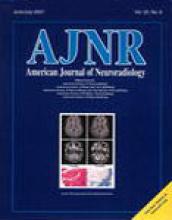Abstract
BACKGROUND AND PURPOSE: Histopathologic studies indicate that aneurysms treated with Guglielmi detachable coils (GDCs) have avascular centers with fibrosis mostly at the aneurysm periphery. We hypothesized that vascular endothelial growth factor (VEGF) released from a coil promotes clot organization, hyperplasia, and endothelial proliferation to facilitate closure of the aneurysm neck.
METHODS: GDC segments were inserted into ligated common carotid arteries (CCAs) of adult male rats for 14 days. Coil segments (4-mm) were unmodified, modified with type I collagen (2.4 mg/mL), or modified with type I collagen and recombinant human VEGF-165 (rhVEGF; 500 μg/mL). CCA segments were harvested and coils removed for scanning electron microscopy (SEM).
RESULTS: Collagen/rhVEGF coils (n = 11) resulted in marked reductions in CCA lumen area (0.03 mm2) compared with coils (n = 9, 0.21 mm2, P < .001) and collagen coils (n = 5, 0.13 mm2, P < .001). Collagen/rhVEGF coils (n = 11) also resulted in marked reductions in CCA diameter (0.19 mm) compared with coils (n = 9, 0.50 mm, P < .001) and collagen coils (n = 5, 0.40 mm, P < .001). Wall thickness was greater for the collagen/rhVEGF coil segments (0.22 mm) compared with coils (0.09 mm, P < .001), and the collagen coils (0.15 mm, P = .06). CCA segments containing collagen/rhVEGF coils also displayed Factor VIII positivity and were completely encapsulated in fibrotic tissue, while the unmodified and collagen coils were essentially smooth, as seen by SEM.
CONCLUSION: These results suggest that rhVEGF may be beneficial in promoting endothelialization, clot organization, and tissue integration of the coils. This is the first study to hypothesize that rhVEGF may be useful as a surface modification to GDCs for enhancing their therapeutic effects in the treatment of cerebral aneurysms.
- Copyright © American Society of Neuroradiology












